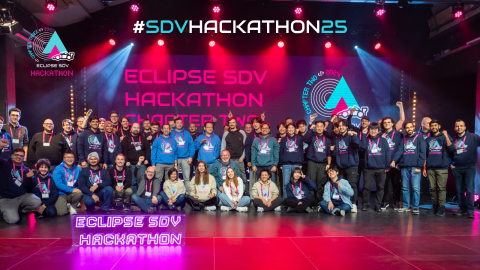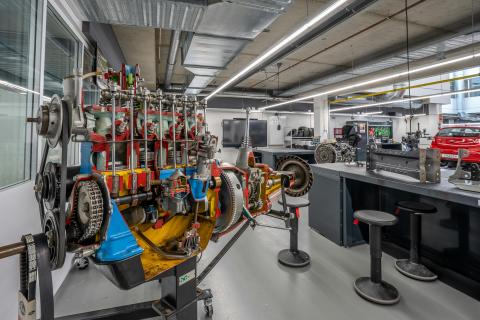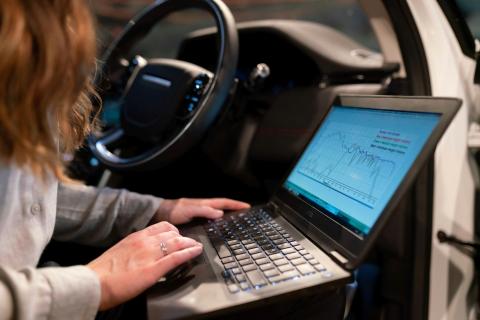Two cities, two challenges: ADAS feature prototyping and OTA updates

The third edition of the Eclipse SDV Hackathon is just around the corner, and we’re excited to introduce the 2025 challenges. This year’s hackathon sharpens its focus with two well-defined challenges that offer clear objectives, comprehensive guidance, and more hands-on development opportunities. Both challenges emphasise speed and agility – from initial development to deployment and continuous improvement – because accelerating automotive innovation has never been more crucial.
If you’ve participated in previous hackathons, you’ll know that selecting the right challenge for your team can be its own challenge. Once you’ve committed to a direction, switching gears is not easy. And with too many options, the decision can become overwhelming.
That’s why, in collaboration with our hackathon coaches and moderators, we’ve taken a new approach for 2025. Instead of presenting several narrowly scoped challenges, we’re offering two broader ones that incorporate a wider range of technologies. Each is designed to provide clearer direction, greater flexibility, and more space to showcase your creativity and coding capabilities. For each challenge, your team can select either a more accessible or a more advanced path, and the evaluation criteria will reflect your choice.
Think of it like a gourmet restaurant: fewer options on the menu, but each one crafted with greater care, more finesse, and packed with even richer flavours.
The 2025 challenges
Let’s explore what’s on this year’s challenge menu.

Challenge 1: Virtual SDV Lab
If you’re enthusiastic about virtualisation, simulation, and the convergence of the physical and digital realms, the Virtual SDV Lab is for you. As the automotive industry increasingly adopts agile software development, virtual platforms have become essential for prototyping, testing, and deploying new features, offering a cost-effective and efficient alternative to in-vehicle testing.
This challenge focuses on exploring how newly developed software features influence vehicle behaviour and how these innovations can be integrated into real-world SDV ecosystems. Your task will be to design, implement, and demonstrate a functional Advanced Driver Assistance System (ADAS) or automated driving feature using a virtual vehicle environment. Modularity is key, as features must integrate seamlessly within a broader system architecture.
You’ll have access to an extensive suite of open source technologies to bring your ideas to life, including:
- Eclipse Zenoh and Eclipse uProtocol for the communication and service layer
- Eclipse Kuksa as a data broker between the Vehicle Signal Specification (VSS) and the application layer
- Eclipse ThreadX as a real-time operating system
- Eclipse Ankaios for distributed orchestration
- CARLA for simulation and testing
- Android Auto for an Infotainment System
Basic programming skills plus some experience with Python, C, Rust, CARLA, and virtual test environments are your ticket into the Virtual SDV Lab. And of course, a passion for open source goes without saying!

Challenge 2: Mission: Update Possible
Both challenges are all about stepping on the gas for SDV development. At the same time, they guide you through the twists and turns of the software lifecycle: While the Virtual SDV Lab challenge focuses on rapid prototyping, testing, and deployment, the second challenge picks up where the first one leaves off: updating and upgrading those nifty features you’ve already built into a vehicle. Fittingly, it carries the upbeat title: “Mission: Update Possible” .
Over-the-air (OTA) updates have long been a Gordian knot for developers working on cyber-physical systems. Varying hardware requirements, regulatory hurdles, security and safety concerns, and connectivity issues are just a few of the many roadblocks SDV developers have faced in rolling out updates. This challenge invites you to build and demonstrate a complete prototype that can deliver secure, traceable, and auditable updates from a cloud-based orchestrator to simulated vehicles.
You’ll work with technologies such as:
- Eclipse Symphony
- Eclipse uProtocol
- Eclipse ThreadX as a real-time operating system
- Eclipse openBSW A Code-first Software Platform for Automotive Microcontrollers
- In-vehicle orchestrators including Eclipse Ankaios and Eclipse Muto
Inspired by international standards such as UN R155 and R156, this challenge is grounded in real-world regulatory and technical requirements. We’ll provide templates, simulated agents, and sample services to help jumpstart your development process.
If you have basic knowledge of container technologies and OCI containers and you are willing to read through the documentation of the involved projects, this is your chance to cut the Gordian knot of OTA updates!
Register today
Whether your team joins the SDV Virtual Lab or the OTA Taskforce, we look forward to seeing your ideas, creativity, and code in action. If you haven’t yet registered, spots are filling quickly – sign up now and help drive the future of SDV development forward.
We’ll see you in Berlin or Porto!
